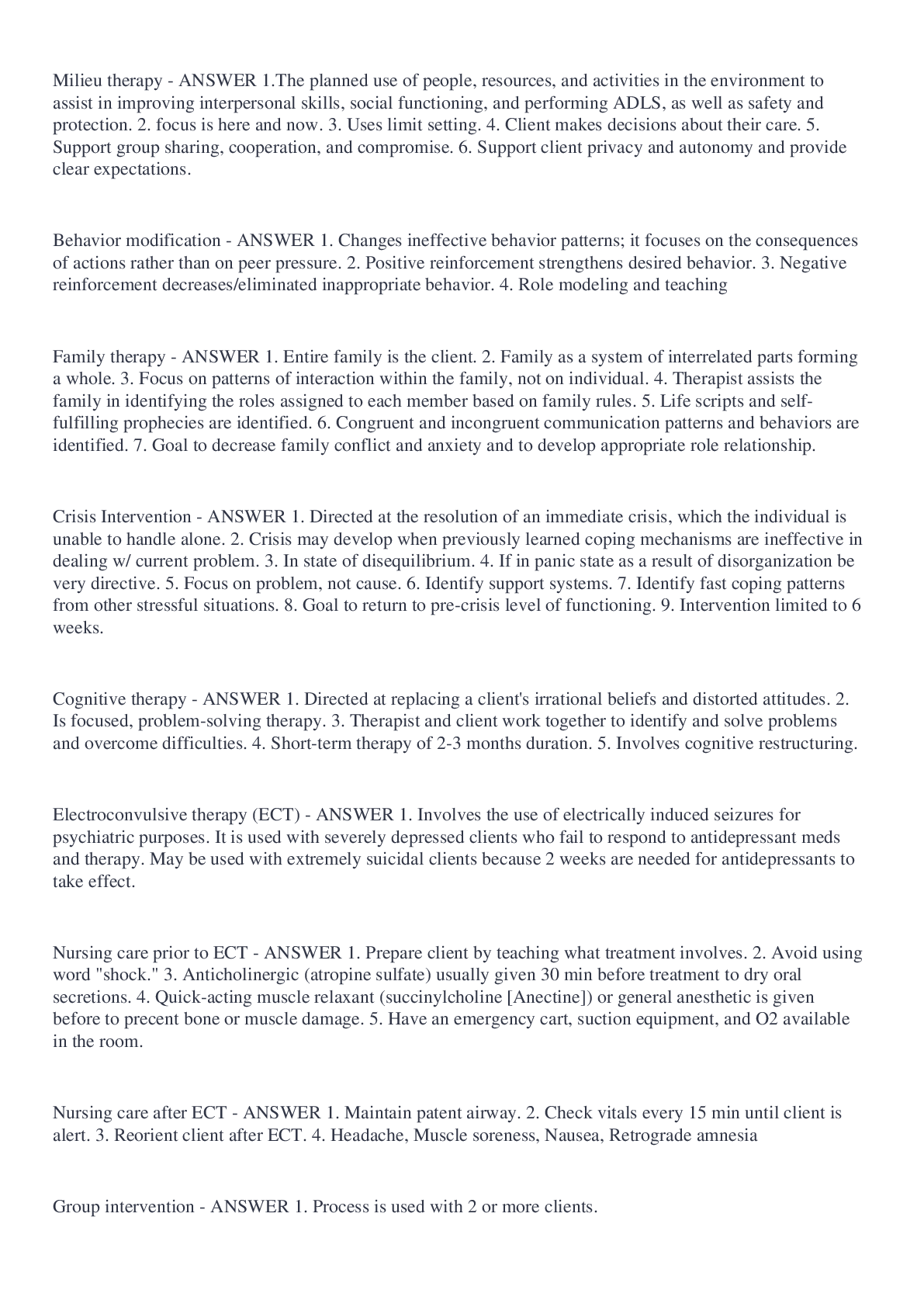NR 602 final week 8 Exam questions With Answers
Document Content and Description Below
NR 602 final week 8 Exam questions With Answers 1 Nr 602 wk 8 poss questons ACOG guidelines regarding well women exams What is the ASCCP recommended management for an ASCUS (atypical squamous cell... s of undetermined significance) pap result with a positive high-risk HPV 16 cotest in a 26-year-old woman without a history of abnormal pap smears? Colposcopy A well-woman visit for an adolescent should include which of the following? A general health history focusing on reproductive and sexual health concerns (menses, gynecologic, and pregnancy related) and psychosocial (family related, peer related, emotional, and physical as well as related to abuse, drug use, and alcohol use) concerns Physical exam, screening tests, and immunizations as indicated by the health history and gynecologic considerations for an external-only inspection of the genitalia ACOG Pap smear guidelines A Bethesda system Pap smear report that reads LSIL is most consistent with which classification? CIN 1 A single Pap smear reading of ASCUS in a patient negative for HPV infection should have what as follow-up? Routine screening A female patient is 35 years old. She has never had an abnormal PAP smear and has had regular screening since age 18. If she has a normal PAP smear with HPV testing today, when should she have the next cervical cancer screening? 5 years A young sexually active client at the family planning clinic is advised to have a Papanicolaou (Pap) smear. She has never had a Pap smear before. What should the nurse include in the explanation of this procedure? The Pap smear can detect cancer of the cervix Lab results on your 26-year-old patient show a negative Pap smear with a positive human papillomavirus (HPV) screen. Which procedure will be required next? Repeat Pap and HPV screen Which of the following is not part of the criteria for an older woman to cease having any future Pap tests performed? Over 55 years of age Amenorrhea (Primary and Secondary) You are evaluating a 17-year-old Emily who presented with amenorrhea and normal secondary sex characteristics. The purpose of the progesterone challenge is to ascertain the presence of? Endogenous estrogen A 17-year-old female patient presents with amenorrhea for 4 months she did experience menarche at age 15 but had not had a menstrual cycle since. On physical examination, it is noticed that she has normal secondary sexual characteristics. The nurse practitioner will consider a progesterone challenge to determine the presence of adequate Endogenous estrogen A teenage patient presents with amenorrhea and moral secondary sex characteristics. A progesterone challenge is ordered. The purpose is to determine the presence of ____________? Endogenous estrogen A 16year old girl who comes to your office with a history of secondary amenorrhea. She experienced menarche at age 10, regular cycles for 2 years. She has not menstruated now for 4 years. In your initial consideration of differential diagnoses, what is the most frequent etiology of this problem: Eating disorder 18yo female c/o secondary amenorrhea. On exam, there is normal secondary sex characteristics and normal genitalia. Pregnancy is ruled out. What would necessitate further eval? Galactorrhea Primary amenorrhea is best described as: Failure to menstruation to occur by 13 yr A nurse practitioner is caring for a woman with primary and secondary amenorrhea. The pelvic exam was normal. Which of the following may be the cause if etiology originates in the hypothalamus? Sheehan’s syndrome American Cancer Society recommendations A nurse practitioner is participating in a women’s health fair. When educating the women about risk factors for breast cancer, which of the following statements is incorrect?2 Nr 602 wk 8 poss questons Fibrocystic breast disease When educating women about breast cancer risk factors, which statement is incorrect? Fibrocystic breast disease A woman with lobular carcinoma in situ has a relative risk of developing invasive breast cancer of 8.0 Androgen insensitivity/resistance syndrome Changes in hormonal regulation during menopause result in the gradual cessation of menstruation. From which gland is Androstenedione secreted? Adrenals ASCUS/HSIL results from Paper Test Report A Pap smear result of atypical squamous cells of undetermined significance—rule out high-grade squamous intraepithelial lesion (ASCUS r/o HGSIL) will require which procedure next? Colposcopy A Pap smear result of atypical squamous cells of undetermined significance (ASCUS) will require which procedure next? Follow up pap smear Bartholin glands and cysts A 25-year-old presents with a report of a very tender area just near her introitus and to the left of her perineum. Very painful sex is how she knew "something wasn't right." She showered and when washing, she felt a "pea-sized" painful lump on the left side of her "bottom." She tells you she looked at it with a mirror and it was very small, but now it is the size of a ping-pong ball and getting worse. When you inspect her external genitalia, you are amazed at the size and appearance of the "lump." You note what appears to be an abscess on the left medial side of the labia minora, and there is some edema extending into the perineum. Your diagnosis for this presentation is: Bartholin’s cyst You explain to this young woman what this "lump" is and let her know you will be referring her to a gynecologist you consult with regularly. You explain to her the likely treatment as follows: A possible incision might be necessary and a catheter placed for two to four weeks to allow for drainage and appropriate healing. A client at the women's health clinic complains of swelling of the labia and throbbing pain in the labial area after sexual intercourse. For what condition does the nurse anticipate the client will be treated? Bartholinitis 25yo female c/o tender area near her introitus and to the L of her perineum. Very painful sex was first sign. Initially bump was very small, but now is ping-pong ball size. On exam, abscess is present on L medial side of labia minora and there's edema extending into perineum. What is dx? Bartholin’s cyst Which of the following choices represents a disorder of the reproductive tract that causes pain, erythema, dyspareunia, and a perineal mass? Bartholin’s cyst A nurse practitioner instructor is reviewing the anatomy of the external genitalia. At the opening of the vagina are the Bartholin's glands. Which of the following describes the function of these glands? Production of alkaline secretions for sperm viability BMI CDC recommendations regarding STDs and PID Cervical cancer screening A 23-year-old women presents to your practice with a chief complaint of postcoital bleeding. Which of the following would NOT be included in the initial assessment of this patient? Uterine biopsy a nurse practitioner is educating a woman who has a colposcopy ordered. Which of the following most accurately describes a colposcopy? A procedure that visualizes the vaginal, vulvar or cervical epithelium with magnification to identify abnormal areas that may need to be biopsied3 Nr 602 wk 8 poss questons A 33-year-old women presents to your clinic complaining of a dark brown watery vaginal discharge and postcoital bleeding. There is a strong history of multiple unprotected sexual encounters. Which of the following findings on examination would be suspicious for cervical cancer? A very firm, easily friable cervix A 23-year-old woman comes to the clinic for a Pap smear. After the examination, the client confides that her mother died of endometrial cancer 1 year ago and says that she is afraid that she will die of the same cancer. Which risk factor stated by the client after an education session on risk factors indicates that further teaching is needed? Late onset menarche The frequency for cervical screening depends on the patient and her age. What is the longest recommended time interval between cervical screens for patients who are 65 years-old or younger? 5 years What is the leading cause of death from a gynecologic malignancy in American women? Cervical cancer Cervix/Uterus examination A 49-year-old female patient presents with a chief complaint of dark, watery brown vaginal discharge. Part of the differential diagnosis includes that of cervical cancer. Which of the following best describes what might be visualized? Ulcerated firm cervix A nurse practitioner is completing a speculum exam on a female patient. Which of the following findings world be considered a normal surface characteristic of the cervix? Small, yellow, raised around area on the cervix In collection of a specimen for a PAP smear, how is the endocervical specimen collected? After the ectocervical specimen with a brush Cimetidine Condyloma acuminate Treatment options for patients with condyloma acuminatum include: Imiquimod (aldera) Which of the following best describes lesions associated with condyloma acuminatum? Verruciform Treatment options for patients with condyloma acuminatum include all of the following except: Topical acyclovir All of the following findings are associated with secondary stage of an infection by the organism Treponema pallidum except : Condyloma acuminate Patient education for condylomata acuminata should include all the following except: Treatment and elimination of visible warts is a sign of cure, and transmission will not occur Jenna was evaluated and diagnosed with condyloma acuminatum. Treatment options for Jenna will include all of the following except: Topical acyclovir Condyloma lata Which condyloma do we see in syphilis? Condyloma lata-flat Contraceptives the cytology (Pap smear) result for a 21-year-old sexually active student whose partner uses condoms inconsistently shows a large amount of inflammation. Which of the following is the best follow-up? Call the patient and tell her that she needs return to the clinic for chlamydia and gonorrhea testing A college freshman who is using oral contraceptives calls the nurse practitioner's office asking for advice. She forgot to take her pills 2 days in a row during the second week of the pill cycle and wants to know what to do. What is the best advice?4 Nr 602 wk 8 poss questons Take 2 pills today and two pills tomorrow, and have your partner use condoms for the rest of the pill cycle A 17-year-old high school student is considering her birth control options. She wants to know more about Seasonale. Which of the following statements is false? It is a progesterone only method of birth control and does not contain estrogen A 35-year-old smoker is being evaluated for birth control choices. The patient has a history of pelvic inflammatory disease (PID) along with an embolic episode after her last pregnancy. Which of the following methods of birth control would you recommend? Condoms and the vaginal sponge (TODAY sponge) A 20-year-old woman visiting the clinic says that she wishes to begin using depot medroxyprogesterone acetate (Depo-Provera) as a form of birth control. What important information should the nurse include when teaching the client about Depo-Provera? Calcium intake and exercise should be increased because of the possible loss of bone mineral density with increasing duration of use A woman questions the nurse about the effectiveness of oral contraceptives. What most important factor about the effectiveness of oral contraceptives should be included in the reply to this question? User motivation A female client who has been sexually active for 5 years is found to have gonorrhea. The client is upset and asks the nurse, "What can I do to keep from getting another infection in the future?" Which statement by the client indicates that the teaching by the nurse was effective? My partner has to use a condom all the time Contraceptives that contain estrogen-like and/or progesterone-like compounds are prepared in a variety of forms. Which contraceptives should the nurse tell clients have a hormonal component? Oral drugs, transdermal agents A client seeking advice about contraception asks a nurse about how an intrauterine device (IUD) prevents pregnancy. How should the nurse respond? It produces a spermicidal intrauterine environment A nurse is teaching a group of women about the side effects of different types of contraceptives. What frequent side effect associated with the use of an intrauterine device (IUD) should the nurse discuss during the teaching session? Excessive menstrual flow A nurse is teaching a female client about the side effects of estrogen in an oral contraceptive. Which common side effect identified by the client indicates to the nurse that the teaching was effective? Nausea A nurse is counseling a female client with type 1 diabetes who requests contraceptive information. What contraceptive method should the nurse recommend? Diaphragm with spermicide What instruction should a nurse include when teaching about the correct use of a female condom? Remove the condom before standing up A client asks the nurse about the use of an intrauterine device (IUD) for contraception. What information should the nurse include in the response? Expulsion of the device, occasional dyspareunia, risk for perforation of the uterus A 16-year-old client has a steady boyfriend with whom she is having sexual relations. She asks the nurse how she can protect herself from contracting HIV. What should the nurse advise her to do? Insist that her partner use a condom when having sex Which form of birth control presents the highest risk to a female patient if she is exposed to a sexually transmitted disease (STD)? Intrauterine device What choice below has no precautions for oral contraceptive pill use? Varicose veins A 21-year-old woman comes into your practice seeking birth control. She has only recently become sexually active and has consistently used condoms for safe sex. Your history reveals that she does not use tampons during her menses and has very little knowledge about female reproductive anatomy. Based on this information, which of the following birth control choices would be least likely to meet her needs for contraceptive management?5 Nr 602 wk 8 poss questons Nuvaring Cystocele Cystocele is best defined as Descent or prolapse of the bladder While a speculum is retracting the posterior vaginal wall, a 51-year-old patient is asked to strain down. There is a bulge from the anterior vaginal wall. This is most likely Cystocele The situation where the bladder forces the anterior vaginal wall down and out is termed Cystocele Which of the following is an effect of estrogen deficiency on paravaginal tissue? Cystocele A woman is admitted for repair of cystocele and rectocele. She has nine living children. In taking her health history, which of the following would the nurse expect to find? Stress incontinence with feeling low abdominal pressure Dysmenorrhea Which of the following substances is responsible for the symptoms of dysmenorrhea? Prostaglandins the first line treatment of severe menstrual cramps that having been occurring for 4 months in a patient with primary dysmenorrhea includes which of the following? Ibuprofen A 40-year-old female presents with an abnormal menstrual cycle with menorrhagia and intermenstrual bleeding. The nurse practitioner suspects the patient may have dysfunctional uterine bleeding (DUB) and orders tests for follicle stimulating hormone (FSH) and luteinizing hormone (LH) levels. Both of these lab values are elevated. What is the most likely cause of DUB in this patient? Onset of climacteric A patient who a nurse practitioner is seeing for the first time has the past medical history of primary dysmenorrhea. She recalls that which of the following is considered as the primary etiology? Prostaglandin production Dysfunctional uterine bleeding (DUB). She is concerned about why this is happening to her. You recall which of the following is the most common cause of DUB? Anovulation Sylvia is 44-year-old women with dysfunctional uterine bleeding (DUB) and is unable to use oral contraceptives. Which of the following medications can be used for management of DUB? Medroxyprogesterone a 24-year-old female patient has been diagnosed with primary dysmenorrhea. Which of the following medications would be would be used as a first line to help control her symptoms? Non-steroidal anti-inflammatory drugs A nurse practitioner is teaching an undergraduate course in women’s health. A student asks about the etiology of the pain that occurs with primary dysmenorrhea. Which of the following response is correct? Prostaglandin release and synthesis Anna, 25-year-old, presents with dysmenorrhea. She states that her sister and mother have endometriosis, so she would like to be evaluated for it. Which of the following is consistent with a diagnosis of endometriosis? Pelvic pain and dyspareunia Which is not a common cause of irregular menstrual bleeding? Anovulation Which of the following is a "classic" symptom of endometriosis? Progressive dysmenorrhea A 16-year-old female is diagnosed with primary dysmenorrhea. She has taken over the counter ibuprofen in 800 mg increments every 8 hours during menses for the past 3 months with minimal relief of symptoms. What intervention will provide greatest relief of dysmenorrhea symptoms? Combined oral contraceptives A woman visits the clinic because she has dysmenorrhea. What goal should the nurse identify for this client? Easing the pain of the client’s menstruation6 Nr 602 wk 8 poss questons This is defined as "cramping pain in the lower abdomen occurring just before or during menstruation in the absence of other diseases." Dysmenorrhea Gravida/Para Interstitial cystitis/ Painful bladder syndrome After treatment for a bladder infection, a client asks whether there is anything she can do to prevent cystitis in the future. What is the best response by the nurse? Increase daily fluid consumption A patient has been diagnosed with interstitial cystitis. The nurse practitioner remembers that this is best defined as _____. A noninfectious disorder of the urinary bladder The nurse practitioner is examining a 29-year-old female with a 3 day history of dysuria and urinary frequency. On examination, the patient is positive for suprapubic tenderness and negative for costovertebral angle (CVA) tenderness. This most likely represents which of the following? Cystitis A twenty-five-year-old patient presents with urinary frequency and urgency. These symptoms have been occurring for three days without fever. A patient with interstitial cystitis would most likely describe their symptoms as _______. Urinary urgency and frequency in the morning and at night Lichen sclerosus A 65-year-old female presents for a health maintenance examination. She complains of a vulvar itching due to what she calls "recurrent yeast infections," and her symptoms have worsened over the last few months. She is sexually active with her husband and has experienced dyspareunia with penetration lately. She always uses a water-based lubricant with intercourse. On examination, you find complete loss of the borders of the labia minora, constriction of the vaginal outlet, and several thin white plaques (like parchment paper) on the vulva. There is no other skin or mucosal involvement. Lichen sclerosus A 65-year-old patient is diagnosed with lichen sclerosus. The woman asks the nurse what this really means. What is the nurse's best response? Lichen sclerosus is a benign condition that is easily treated.” Lichen simplex chronicus The appearance of lichen simplex chronicus is best described as Diffusely red to red-brown Mammogram A patient ask why she needs a breast ultrasound when she already has had a mammogram. Which of the following would be the best response of the use? to determine if a breast lesion is cystic or solid A 55-year-old female patient presents with pain in the upper outer quadrant of her left breast for over 1month now. The best course of action would be to _________. Perform a breast examination and order a mammogram A 24-year-old female presents to the practice with a painless 2 cm, lobular mass in the right breast that is freely mobile and firm. This has noted on self-breast examination, and she reports it has been unchanged for the past 3 months. The best course of action by the nurse practitioner would be to __________. Order a diagnostic ultrasound or diagnostic mammogram When educating a patient about the rationale for obtaining a mammogram, which of the following statements is false? Mammography detects all breast cancers A 55-year-old women presents to the clinic for evaluation of a breast mass. Which of the following is not a typical presenting sign of breast cancer? A 2cm, rubbery, tender lesion7 Nr 602 wk 8 poss questons During a breast exam of a 30-year-old nulliparous female, the nurse practitioner palpates several rubbery mobile areas of the breast tissue. They are slightly tender to palpation. Both breasts have symmetrical findings. There are no skin changes or any nipple discharge. The patient is expecting her menstrual period in 5 days. Which of the following would you recommend? Tell her to return 1 week after her period so her breast can be rechecked Which of the following statements is accurate regarding the usefulness of mammo in screening and detection of breast cancer? All women >40 year should have a mommo on an annual basis A 45-year-old woman has an abnormal screening mammogram. The next step in management should be Diagnostic mammogram What recommendation should be made to a 70-year-old female regarding mammograms? She should have them annually as long as she has a reasonable life expectancy Metronidazole A nurse is caring for a client who has contracted a trichomonal infection. Which oral drug should the nurse anticipate that the health care provider will most likely prescribe? Metronidazole (flagyl) An important part of patient education for the patient with bacterial vaginosis who is receiving a prescription for oral Metronidazole is: Avoid alcohol for 48 hours after completing medication For the patient with chronic bacterial vaginosis, the nurse practitioner will prescribe: Metronidazole gel .75% vaginally 1-2 times a week for 4-6 months Molluscum contagiosum The differential diagnosis for genital ulceration includes all of the following except : Molluscum contagiosum When molluscum contagiosum is found on the genital area of children, which of the following is the best explanation? It should raise the suspicion of child abuse Tina is evaluated and diagnosed with Molluscum Contagiosum. The nurse practitioner understands that clinical presentation of this disease is characterized by: Fleshy, popular skin colored lesions with indented centers that contain white curdlike material Nabothian glands Small, pale yellow, raised, and rounded areas are visualized on the surface of the cervix. You should: chart this as nabothian cysts. PCOS Elevated triglyceride levels, low HDL levels, and elevated LDL levels are associated with PCOS A 34-year-old woman comes to see you in the office complaining of facial and abdominal hair growth and severe acne. She tells you that although her sister also has some facial hair, her worsening changes are dramatic as compared with family members. Which of the following is the most likely explanation for her symptoms? PCOS The blood test result most consistent with supporting the diagnosis of PCOS is Androstenedione at the upper limits of normal or increased An adolescent female has had normal menses for almost 2 years. She has not had menses in 3 months. She is diagnosed with polycystic ovarian syndrome (PCOS). What else is a common finding? Elevated insulin levels A woman has been diagnosed with polycystic ovary syndrome (PCOS). Management of PCOS includes all of the following except ___________. Daily basal insulin to reduce blood sugar A nurse practitioner is reviewing the chart of a woman who has findings consistent with polycystic ovary syndrome (PCOS).The diagnostic criteria for PCOS include all of the following except: Male pattern baldness8 Nr 602 wk 8 poss questons A nurse practitioner is reviewing the signs of polycystic ovary syndrome (PCOS) for a differential diagnosis for a female patient. Which of the following would be a positive finding? Chronic anovulation PID An 18-year-old waitress is diagnosed with pelvic inflammatory disease (PID). The cervical Gen-Probe result is positive for Neisseria gonorrhoeae and negative for Chlamydia trachomatis. All of the following statements are true regarding the management of this patient except: Repeat the gen probe test for chlamydia trachomatis to ensure that the previous test was not a false negative result Women often tend to reschedule a well woman visit but they don’t do so often with a problem such as pelvic pain. This symptom can present as an acute or chronic, insult. When a woman presents with pelvic pain, the term can encompass many possibilities. Differentiating acute from chronic assists with narrowing down the possibilities but nonetheless can originate from more than one system as a referred pain or discomfort. Which of the following choices are of a reproductive and pelvic origin? Salpingo-oohoritis (fallopian tube/ovary) secondary to PID Women with PID typically present with all of the follow except: Leukopenia 22yo female c/o pelvic pain. Exam reveals cervical motion and uterine tenderness. Which supports PID dx? Mucopurulent vaginal discharge women with a history of pelvic inflammatory disease (PID) have an increased risk for all of the following except: ovarian cyst The nurse practitioner understands that a complication of gonoccocal and chlamydial genitourinary infection in women include which of the following: PID Pyelonephritis Complications of gonococcal and chlamydial genitourinary infection in women include all of the following except: Acute pyelonephritis Rectocele Rectocele is best defined as Decent or prolapse of the rectum Skene’s glands A nurse is describing the Skene glands, explaining that these glands would be found at which location? On either side of the urethral opening Which of the following findings indicates a possible gonococcal infection? Discharge from urethra or Skene glands STDs Patients who are diagnosed with gonorrhea should also be treated for which of the following infections? Chlamydia trachomatis Which of the following is the best method to diagnose a vaginal trichomonas infection? Wet smear with microscopy A 30-year-old woman who is sexually active complains of a large amount of milk-like vaginal discharge for several weeks. A microscopy slide reveals a large number of cells that have blurred margins. Very few white blood cells are seen. The vaginal pH is at 6.0. What is most likely? Bacterial vaginosis A 25-year-old woman complains of dysuria, severe vaginal pruritus, and a malodorous vaginal discharge. Pelvic examination reveals a strawberry-colored cervix and frothy yellow discharge. Microscopic examination of the discharge reveals mobile organisms that have flagella. The correct pharmacological therapy for the condition is: Oral metronidazole (flagyl) A patient diagnosed with bacterial vaginosis should be advised that her sexual partner: Does not need treatment All of the following are infections that affect mostly the labia and vagina except: Chlamydia trachomatis A 25-year-old obese female with type 2 diabetes mellitus presents to your office with a complaint of vaginal itching and burning for 2 weeks. She has tried douching with an OTC cream with no relief. Physical examination, the vulva9 Nr 602 wk 8 poss questons is deep red with some thick white adherent material. Which of the following conditions would be most likely cause of her symptoms? Fungal infection A young woman presents to your practice with vaginal itching and white discharge. She denies sexual activity or douching. She has been in good health except for a recurrent strep throat. Pelvic examination reveals a tender vulvovaginal area with edema and white patches, no odor is detected. Which of the following is the most likely cause of this problem? Candidiasis after antibiotic treatment A patient has symptoms consistent with chlamydia. Which laboratory test gold standard? In the diagnosis? Nucleic acid amplification test A woman presents to your practice with vaginal itching and a white discharge. She has been in good health except for recent treatment for strep throat. Pelvic examination reveals a tender vulvovaginal area with edema and nonmalodorous white patches. Which of the following is most likely cause of this problem? Candidiasis A 39-year-old female has just completed a course of amoxicillin for treatment of streptococcal pharyngitis. Her LMP was 2 weeks ago and reports that it was normal for her. On physical examination, there is some erythema of the eternal genitalia with a small amount of white discharge. The macroscopic wet prep examination revels few clue cells but an abundance of budding hyphae. There are no WBC’s present. considering the differential diagnoses and results of the microscopic examination, which of the following would be the most appropriate. Fluconazole tablets 150mg as one-time dose A 24-year-old female presents to the office with a complaint of vaginal itching in addition to thick mucoid discharge. She also has some mild urinary discomfort. The wet mount preparation using potassium hydroxide. (KOH) reveals a negative whiff test and few clue cells. There was no trichomonas visualized but the WBCs were too numerous to count. Which of the following would be the most likely diagnosis in the patient? Chlamydia The patient has been diagnosed with trichomoniasis. Which of the following medications would be the best options? Metronidazole 2g 25yo female c/o vaginal irritation and discharge. On exam, cervix is easily friable and erythematous. No adnexal tenderness. Wet prep reveals mobile protozoa on NS slide. This most likely represents: Trichomonas Woman is experiencing vaginal discharge. Wet mount with KOH would be used to confirm: Candidiasis A 21-year-old female presents with three 0.5 cm human papilloma virus (HPV) lesions on her vulva. An appropriate treatment option for this patient would be: podophyllin A 25-year-old woman comes to the clinic complaining of increased vaginal discharge, milky gray in color with a "fishy" odor that both she and her husband have noticed. A wet smear is performed and the presence of "clue cells" confirmed. Which type of infection does the nurse suspect? Bacterial vaginosis A nurse in the family planning clinic reviews the health history of a sexually active 16-year-old girl whose chief concern is a thick, burning discharge accompanied by a burning sensation and lower abdominal pain. After an examination the girl is informed that she may have a sexually transmitted infection (STI) that requires treatment. The adolescent is concerned that her parents will discover that she has been sexually active and asks the nurse whether her parents will be contacted. The nurse explains that her parents will: Not be contacted, because treatment at the clinic is confidential A woman visits the clinic for an annual physical examination, and herpes genitalis is diagnosed. The client asks how the disease can be diagnosed without any tests. How should the nurse reply? You have blisters on the skin around your vagina The clinic nurse is planning care for a client found to have Chlamydia. Which treatment should the nurse plan to implement? Administration of azithromycin (Zithromax)1 g orally in a single dose The clinical syndrome resulting from replacement of normal vaginal flora with anaerobic bacteria is: Bacterial vaginosis A patient has symptoms consistent with Chlamydia. Which laboratory test would aid in the diagnosis?10 Nr 602 wk 8 poss questons Culture and sensitivity A 19-year-old sexually active female presents to your urgent care center with a foul smelling vaginal discharge. She has noted the discharge for about 3 days. On examination, she is in no acute distress, and her vital signs are normal. Her pelvic examination is remarkable for mild vaginal erythema and a frothy gray discharge. You note a malodorous discharge and suspect Trichomonas (bacterial vaginosis can also be malodorous, of course, with a fishy smell). A wet prep confirms your diagnosis. Chlamydia and gonorrhea Stein-Leventhal Syndrome The Stein-Leventhal syndrome is characterized by each of the following except Many corpora lutea present in the ovaries Turner’s syndrome Which of the following is NOT a characteristic of Turner syndrome? Increased risk for leukemia Which of the following statements is NOT true about Turner syndrome? Unlike Down syndrome, risk does not increase with an increase in maternal age Which of the following is common treatment for individuals with Turner syndrome? Estrogen therapy. This helps the girls with breast development and their menstrual cycle. Does the X chromosome more commonly come from the mother or father in girls with Turner syndrome? The x more commonly comes from mom USPSTF recommendations regarding breast exams Uterine Prolapse During a pelvic exam on a seventy-year-old, the nurse practitioner notices the position of the cervix at the introitus. The diagnosis is most likely _____. Uterine prolapse Uterine prolapse is caused by a relaxation of the ? Cardinal ligaments UTI In women, most urinary tract infections occur through: Ascending contamination from the urethra A woman with a lower urinary tract infection is least likely to experience which of the following symptoms? Fever Approximately what percent of women will suffer a urinary tract infection at some point in their lives? 60% Urinary tract infections are commonly seen in primary care. A 25-year-old female presents with a new onset of dysuria and suprapubic pain for the last twenty-four hours. The examination reveals only mild tenderness without any peritoneal signs on the lower abdomen. A urinalysis reveals the presence of WBCs. The urine is sent for a culture and sensitivity. In addition to Escherichia coli one might typically expect to see the presence of which bacterium? Klebisiella Vulvar carcinoma/ Pelvic mass What percent of vulvar carcinomas are of the squamous cell type? 90% Paget disease of the vulva may be associated with carcinoma of the Skin In patients with vulvar carcinoma, what is the most common presenting complaint? Vulvar pruritus The spread of squamous cell carcinoma of the vulva is best characterized by which of the following? Spread of the disease is typically to the regional lymph nodes What is the recommended procedure for the evaluation of a chronic vulvar ulcer? Biopsy The most common cause of the delay in diagnosing vulva carcinoma is the Failure to biopsy lesions11 Nr 602 wk 8 poss questons 35yo woman c/o 6mo h/o hypermenorrhea, backache, pelvic pressure. On exam, you discover 12wk size uterus w/irregular contour. What does this represent? Uterine fibroid You are completing a pelvic exam on 32-year-old Nancy. You detect a left adnexal mass on the bimanual exam. With an adnexal mass, the practitioner must always suspect ________ until proven otherwise. Malignancy Vulvodynia A 28-year-old happily married woman presents with new-onset insertional dysparenunia. The most likely diagnosis is o Vulvar vestibulitus All of the following medications may be used for neuropathic pain management of vulvodynia, except: o SSRI’s The nurse practitioner understands that which of the following lab tests is appropriate for the patient who presents with symptoms of dysesthetic vulvodynia? [Show More]
Last updated: 1 year ago
Preview 1 out of 11 pages
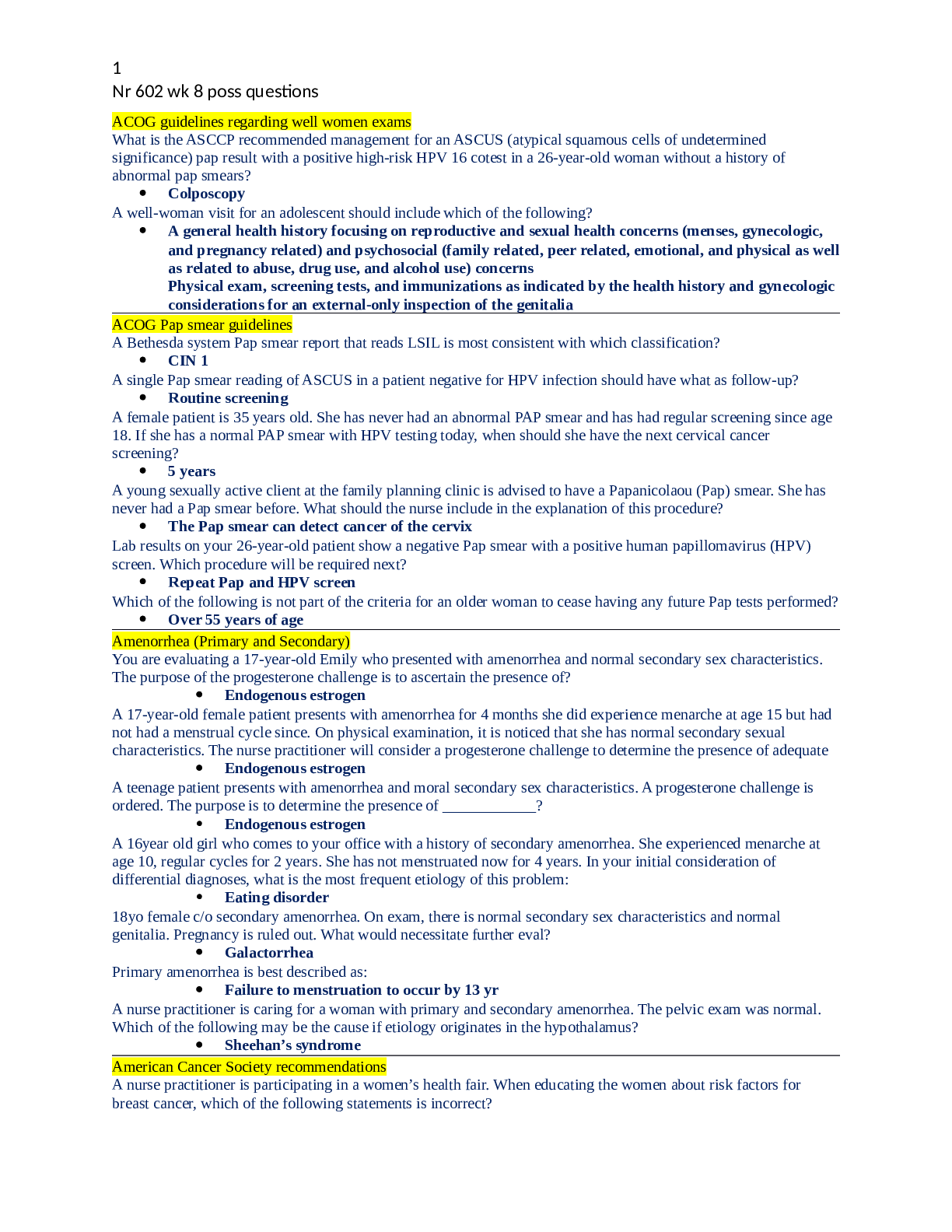
Reviews( 0 )
Document information
Connected school, study & course
About the document
Uploaded On
Nov 07, 2022
Number of pages
11
Written in
Additional information
This document has been written for:
Uploaded
Nov 07, 2022
Downloads
0
Views
32



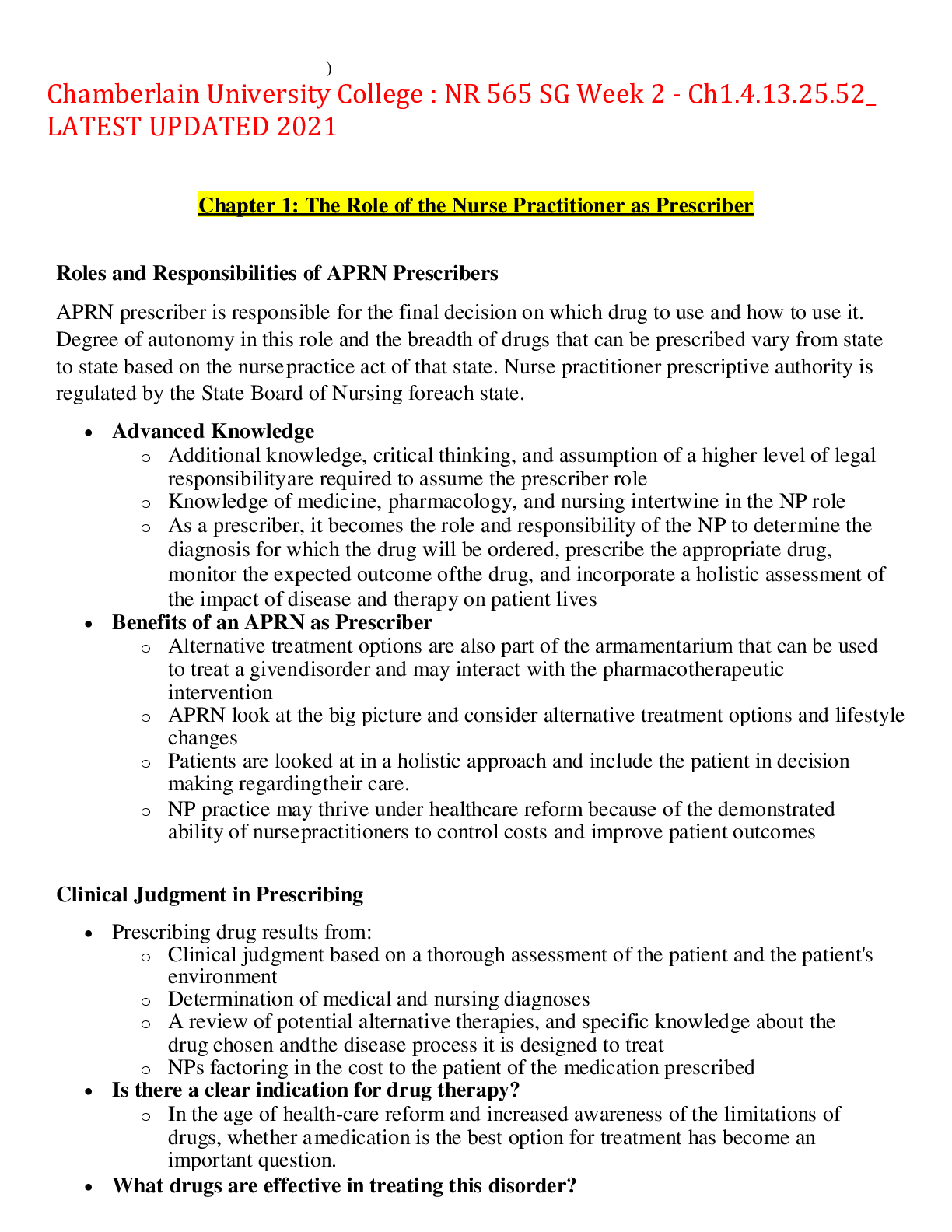
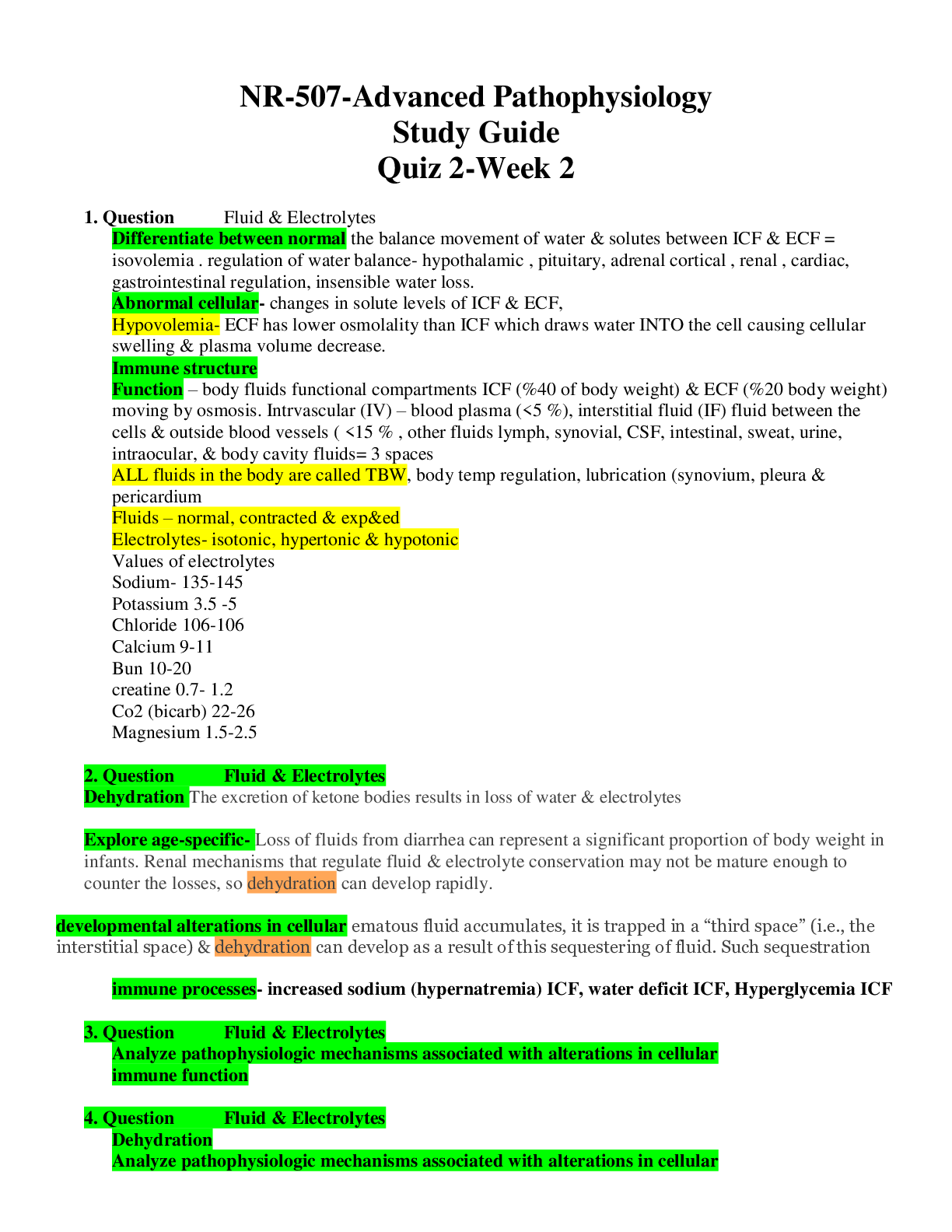
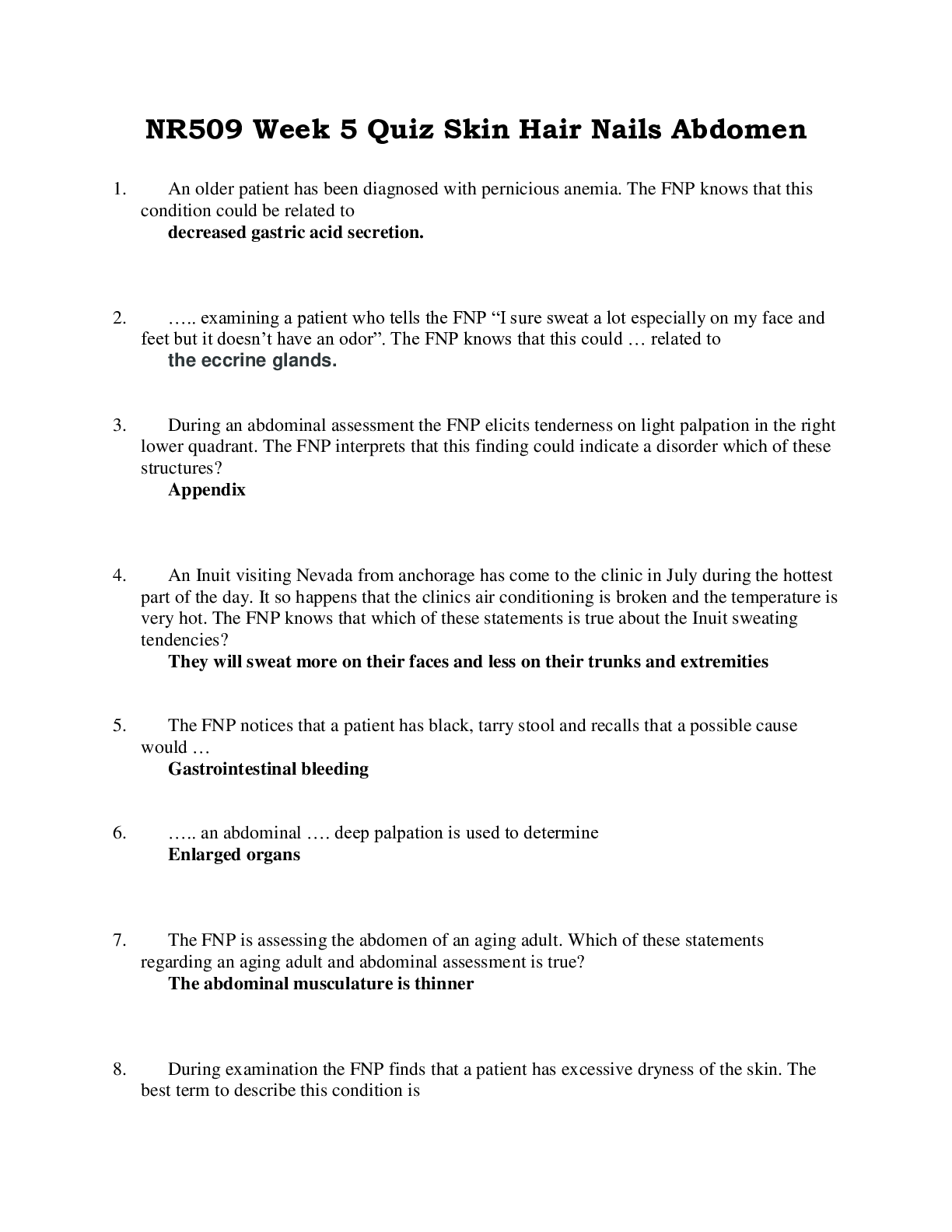
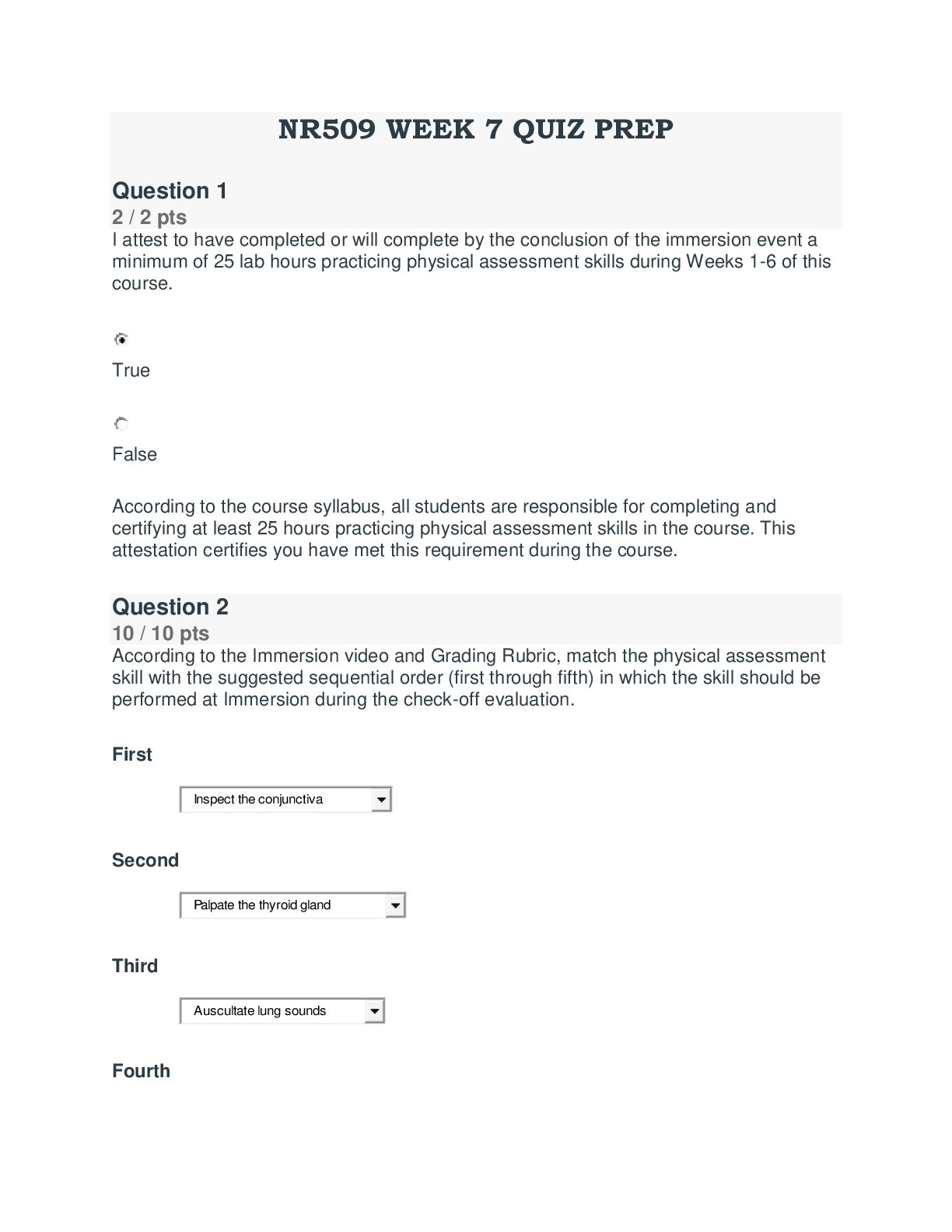
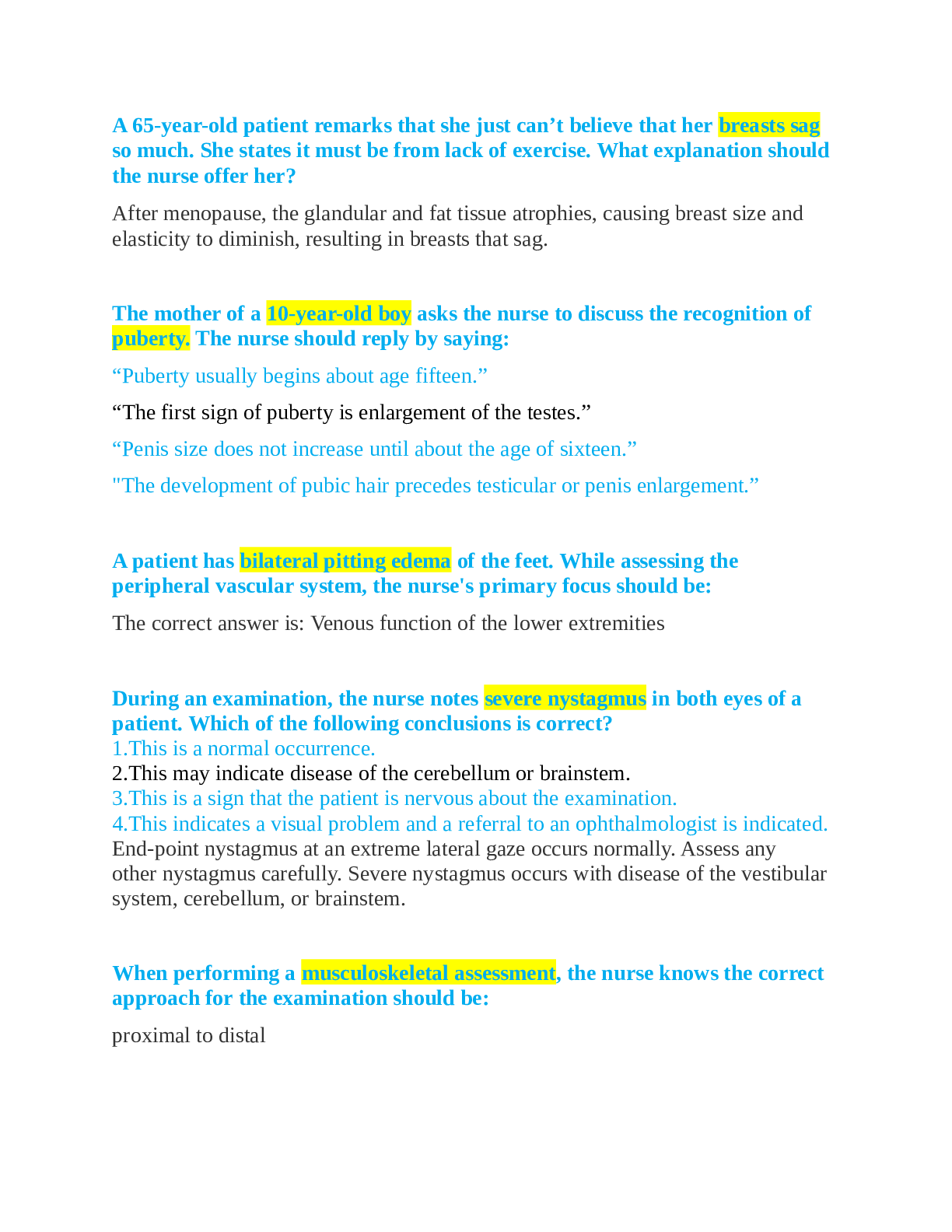

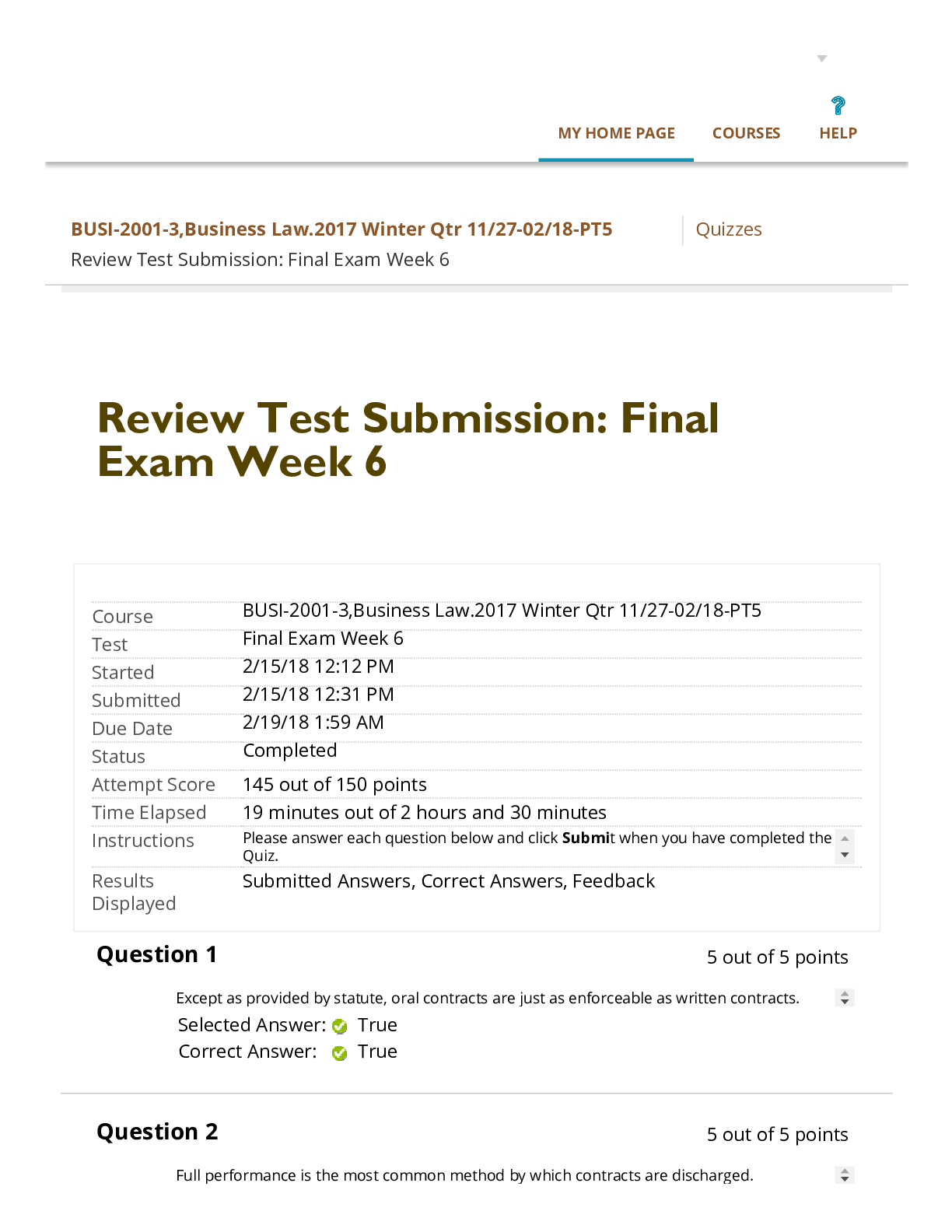

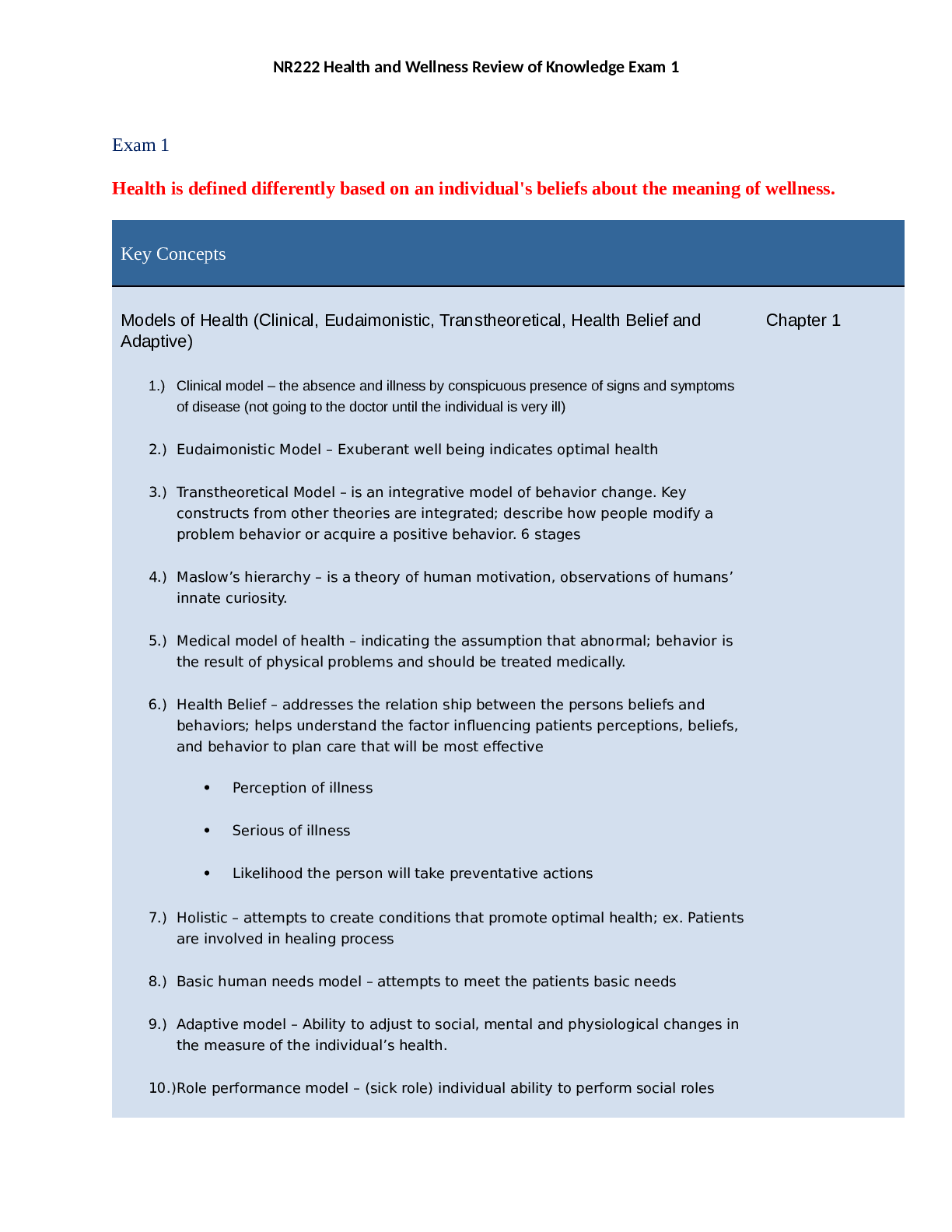
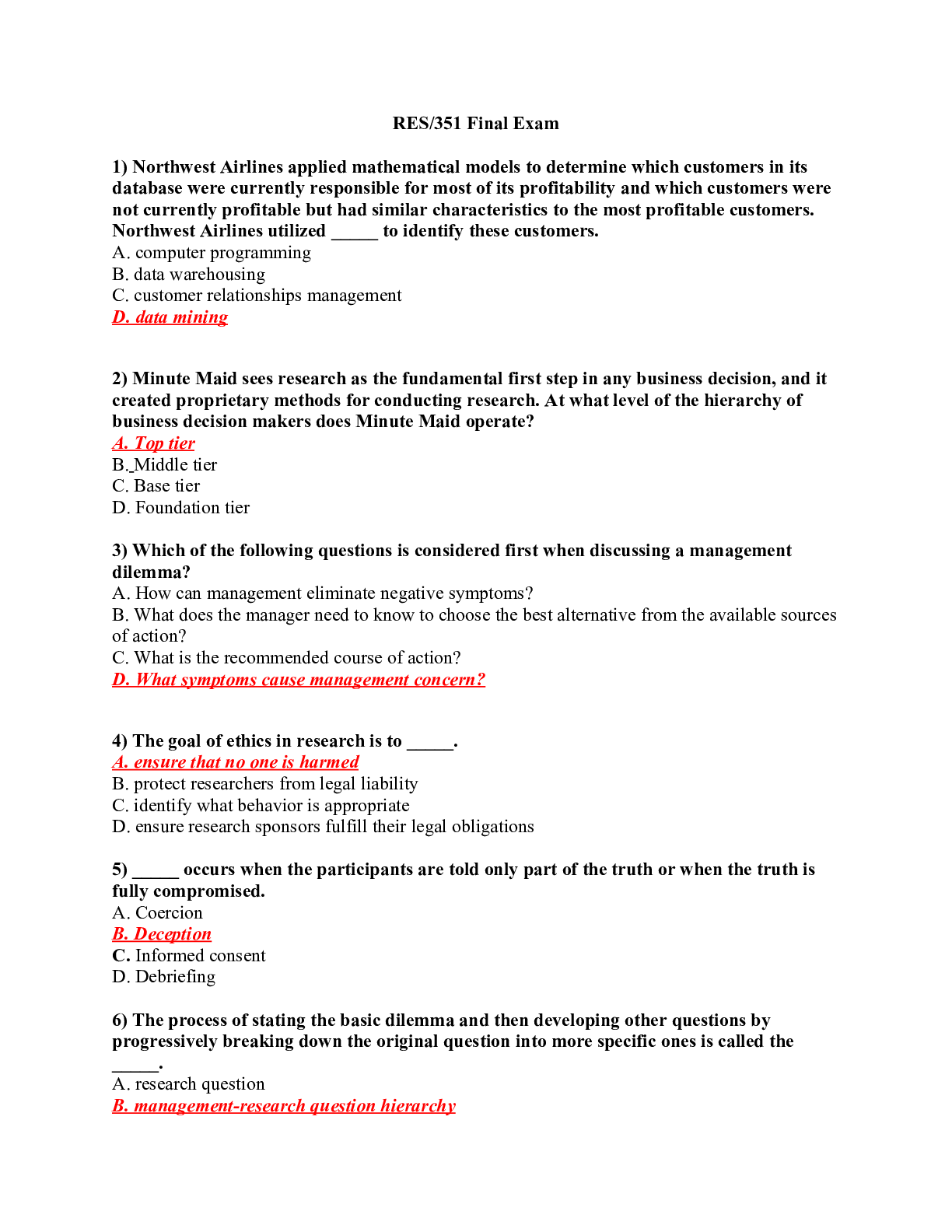
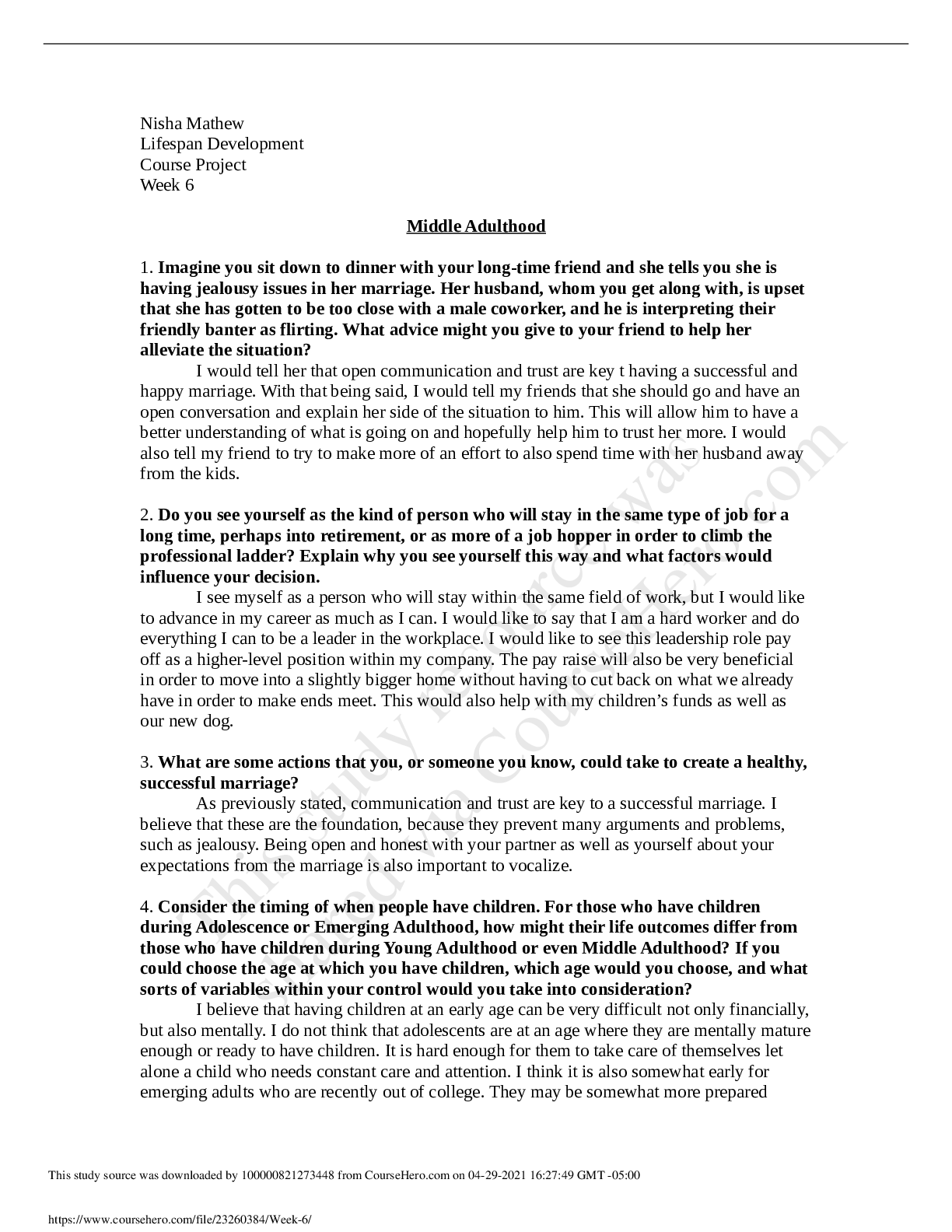

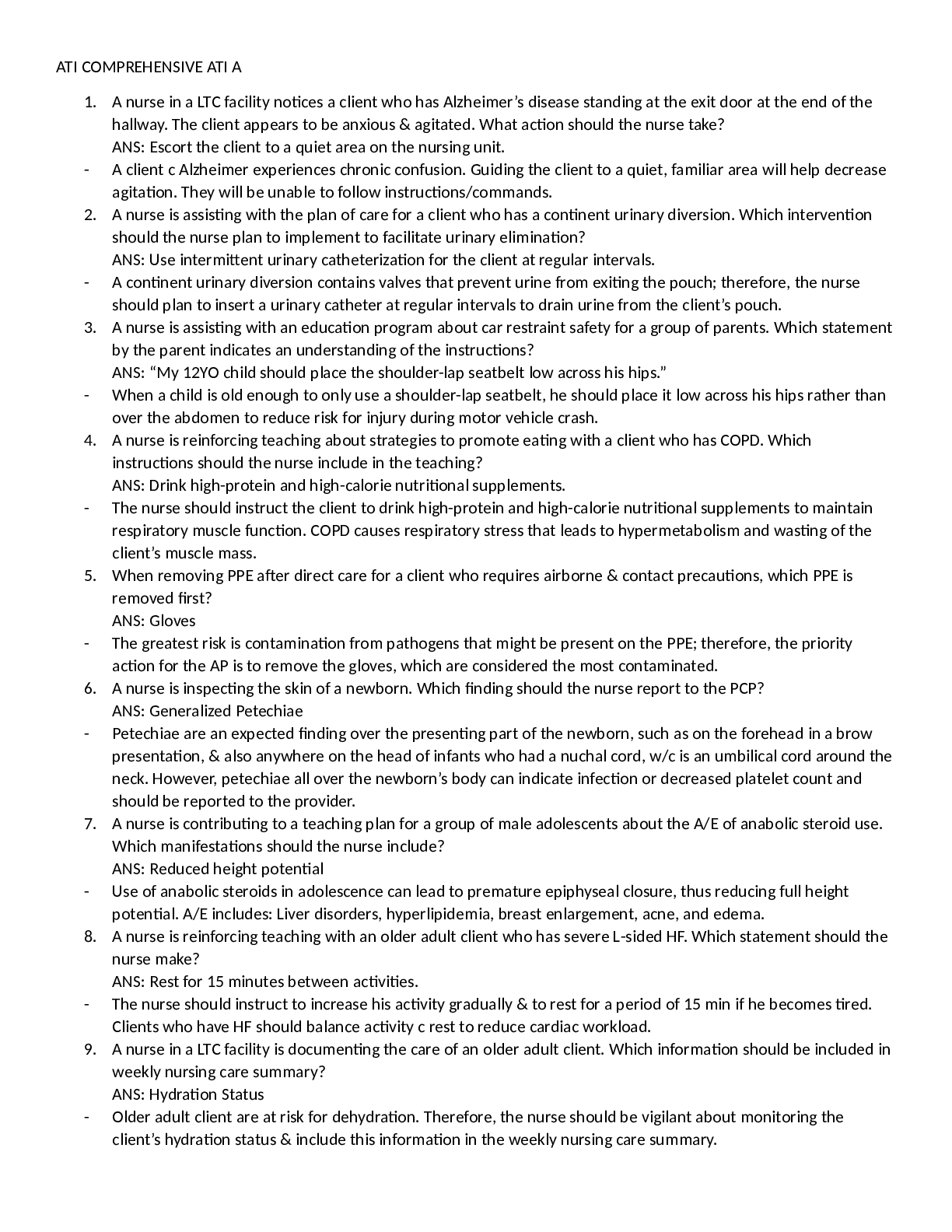

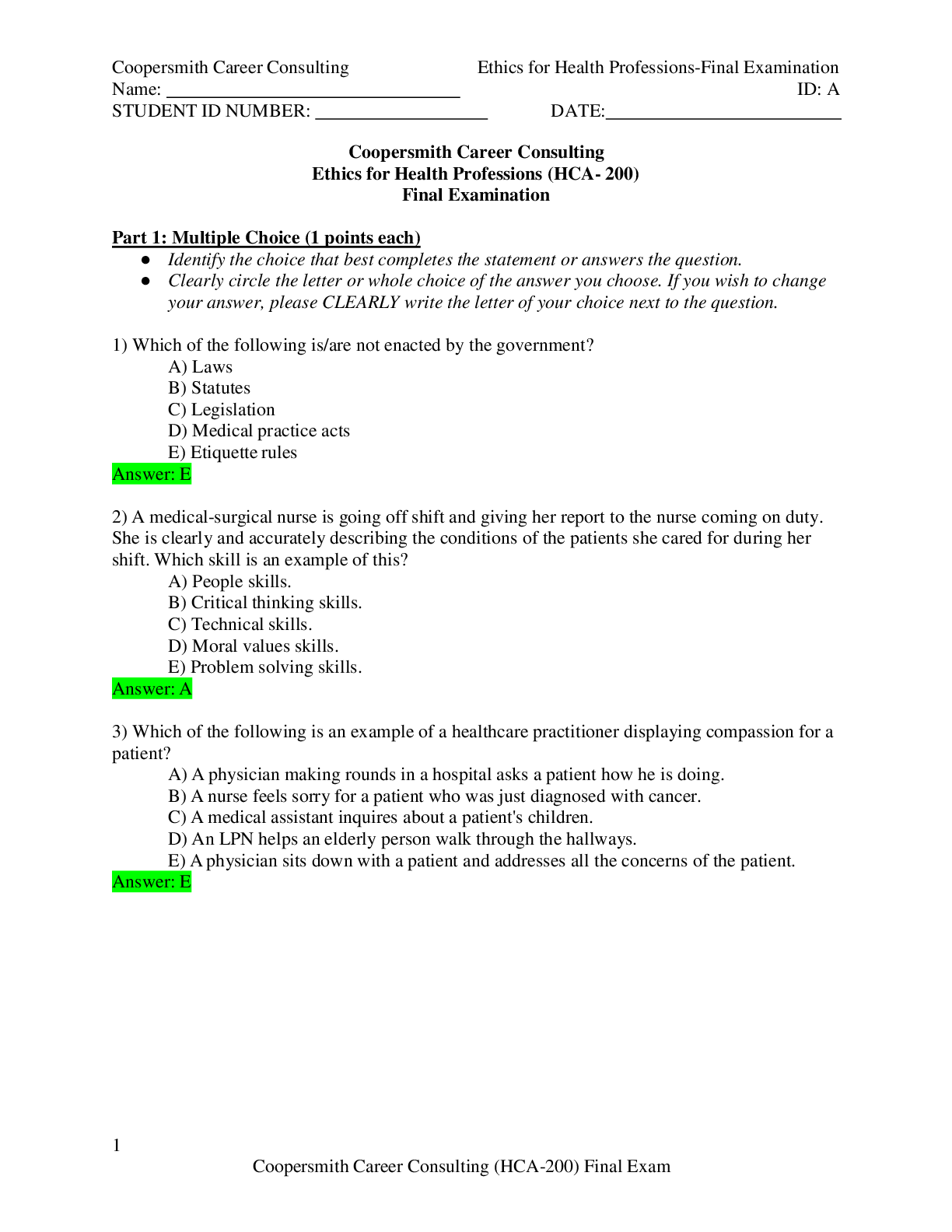
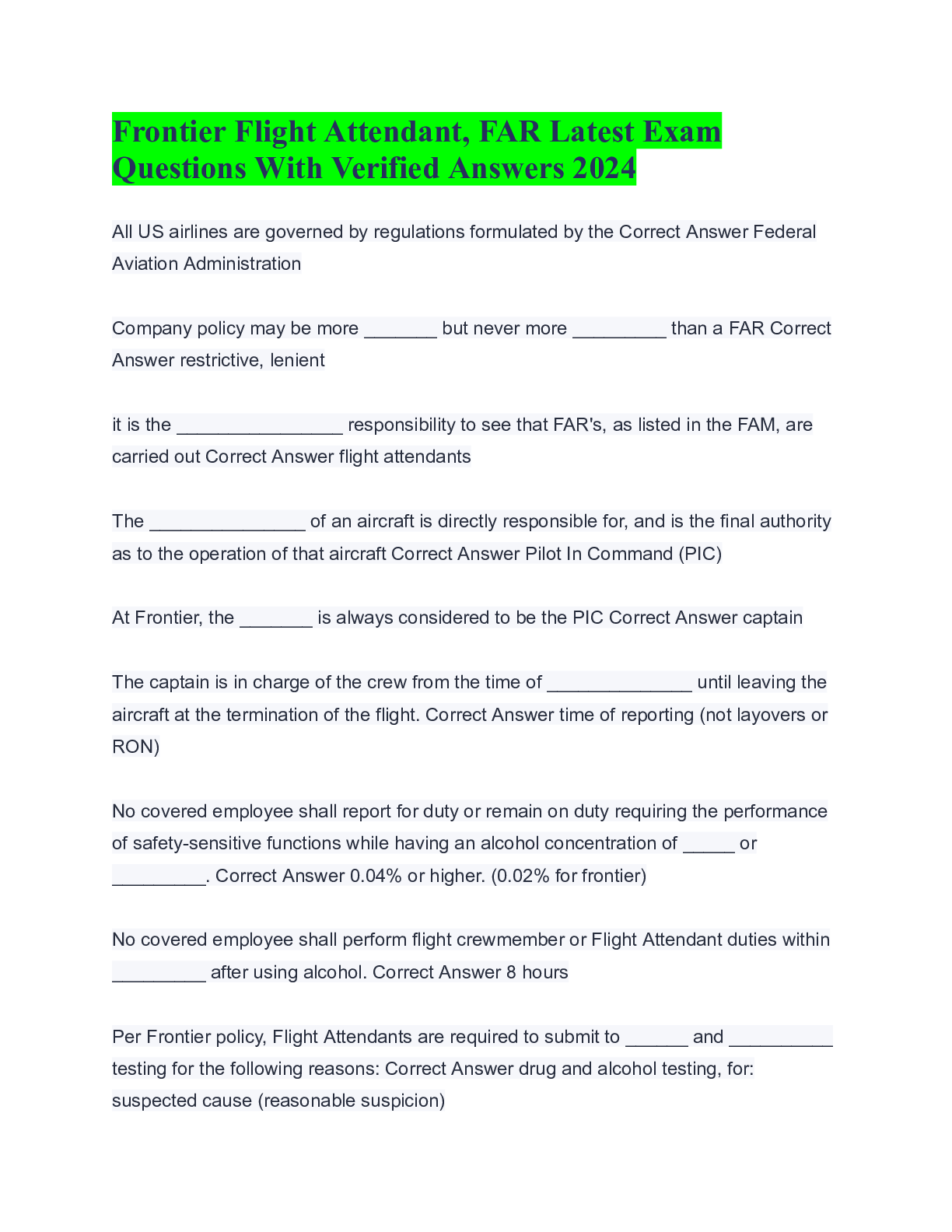
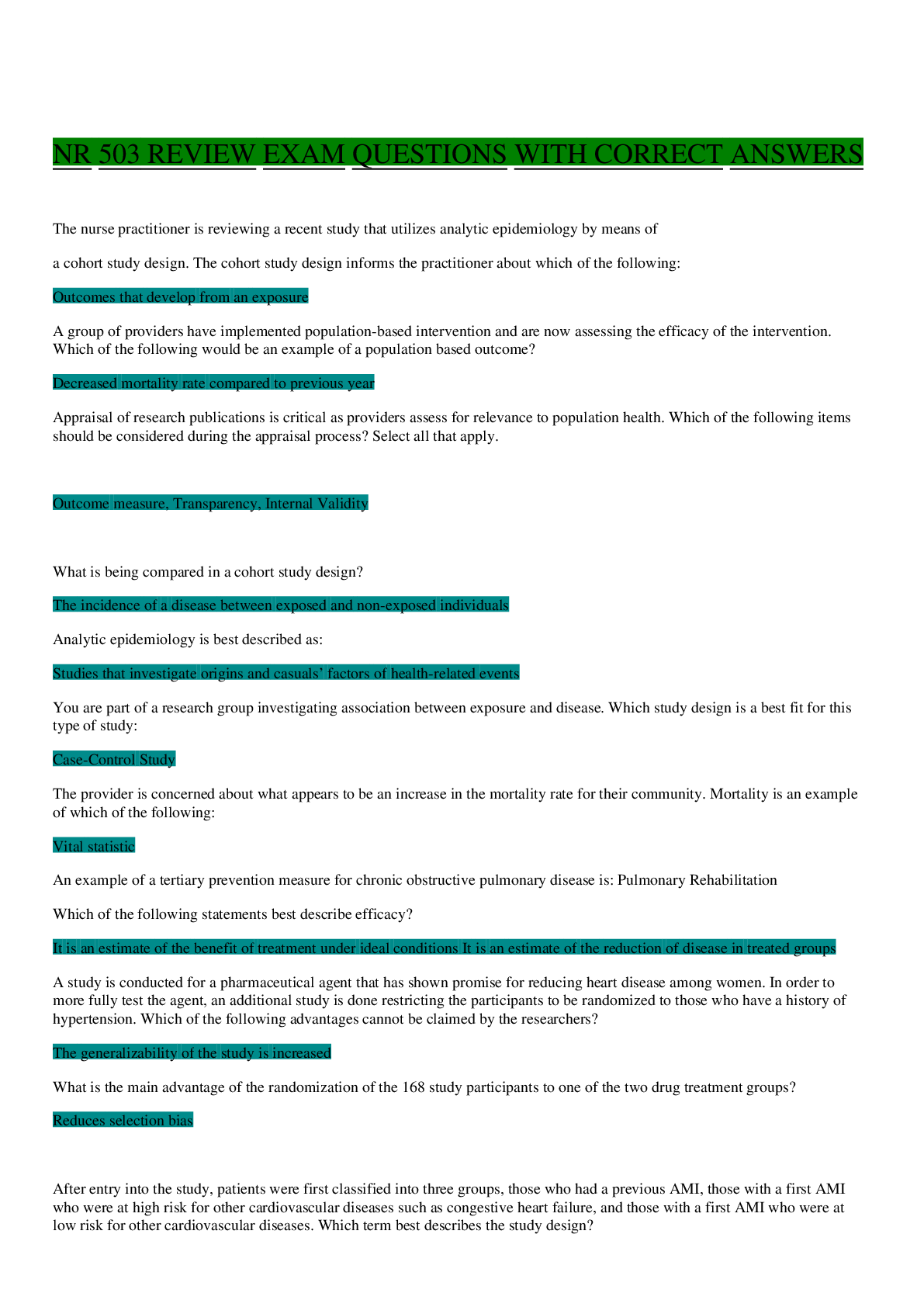


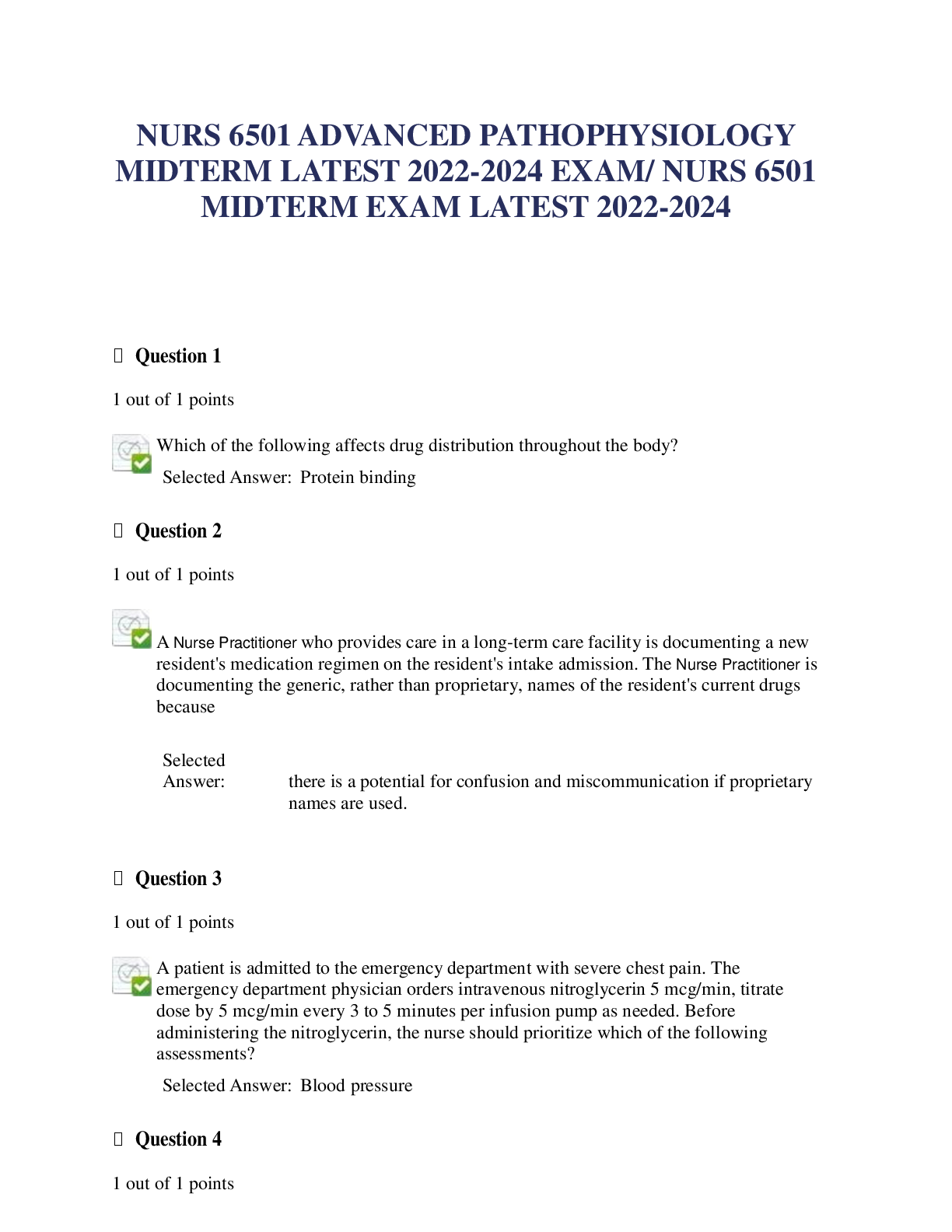

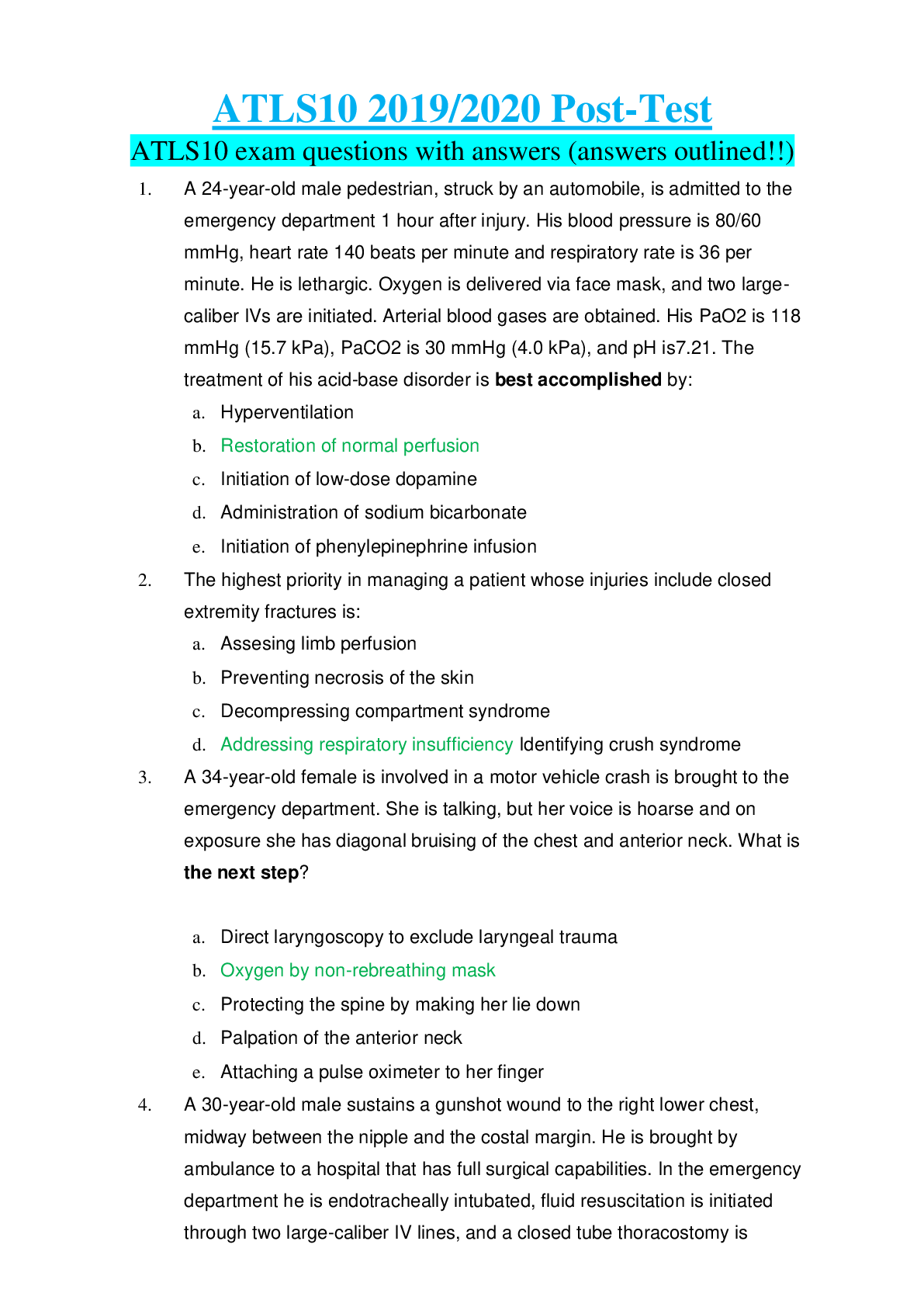
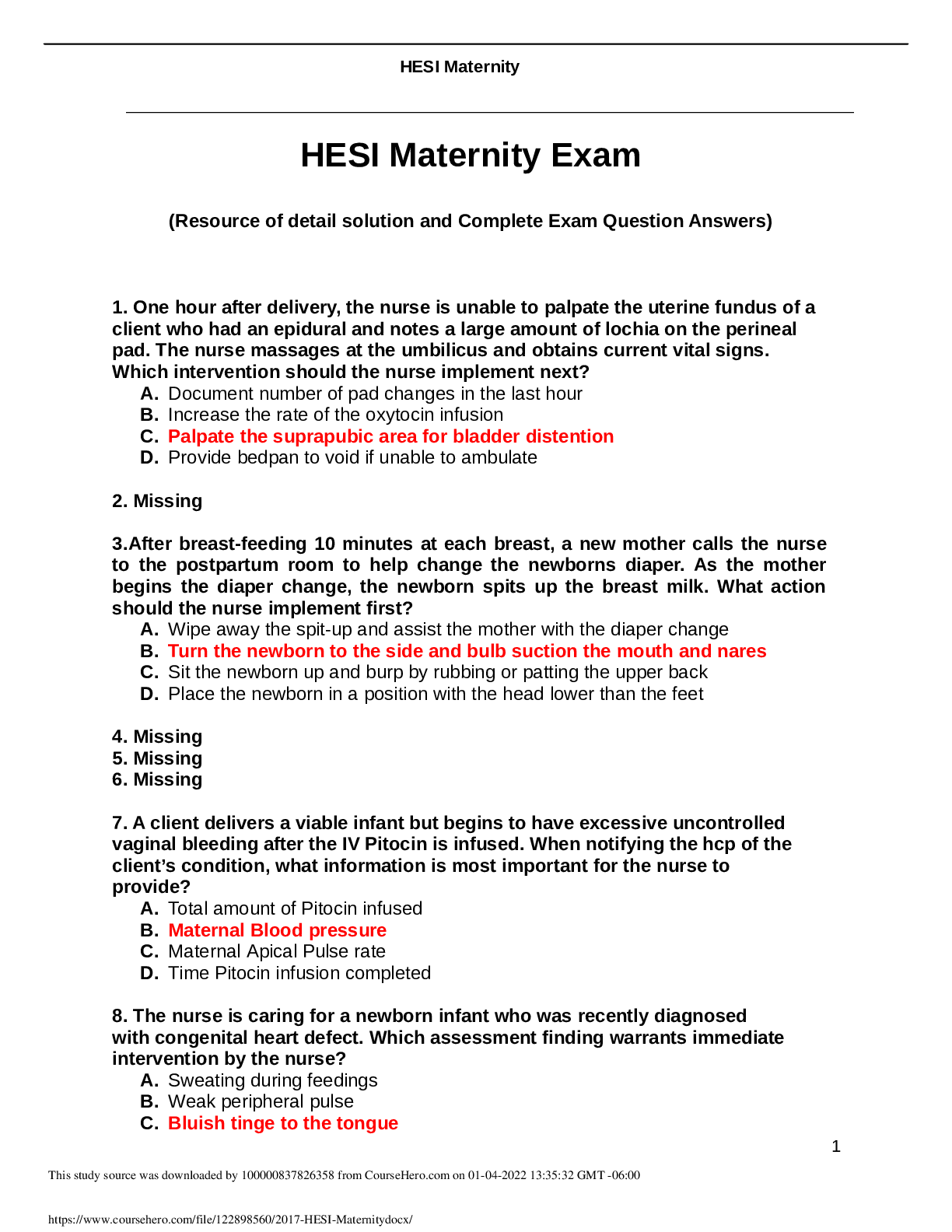
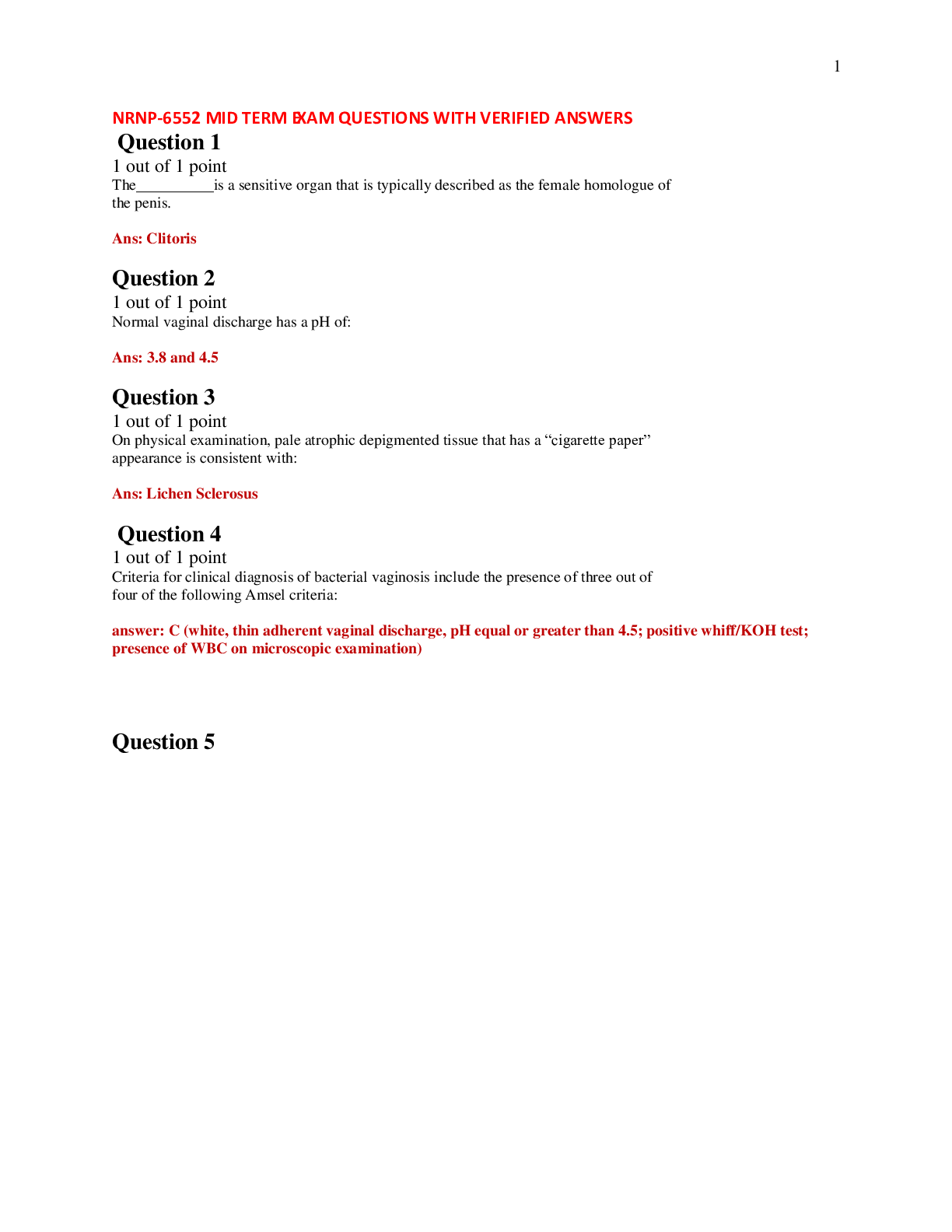
.png)
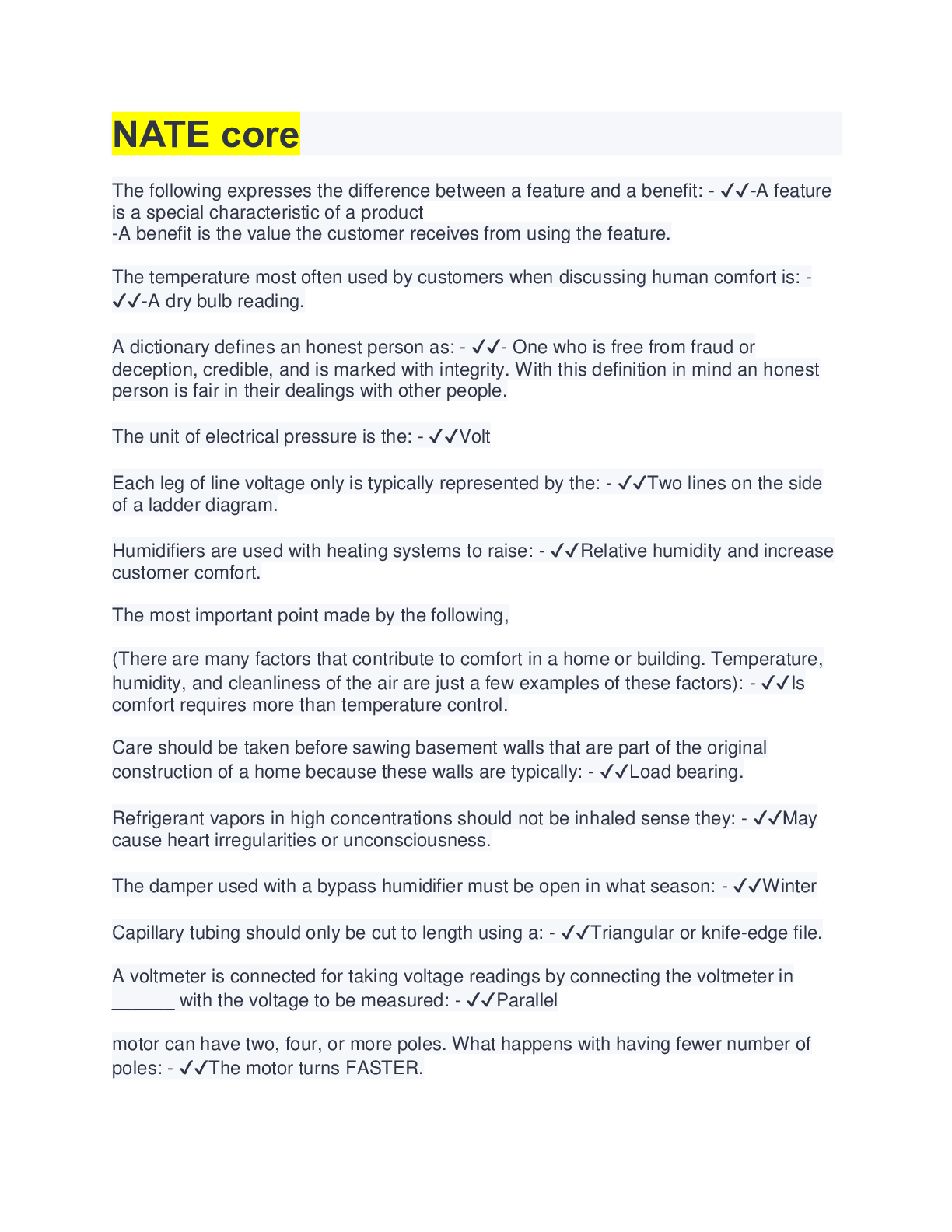
 EXAM.png)



